A couple of weeks ago, I got an email from Hal Laessig, a Newark architect, developer, and artist who was a graduate student of Daniel Libeskind’s at Cranbrook, and who came back to build three fantastical, fantasy machines for LIbeskind’s contribution to the 1986 Venice Architecture Biennale, curated by Aldo Rossi. Titled “Three Lessons of Architecture,” the show was an argument-by-metaphorical-object about the post-structuralist concept of architecture-as-text. But the three machines were anything but fantasies: they were incredibly complex, and laboriously and meticulously designed and constructed from the barest possible historical references.

The Reading Machine [l] and The Memory Machine [c] were both based on the 16th century proposals: the former, a design for a multi-book “Reading Wheel” by Agostino Ramelli, and the latter a complete reimagining of the backstage apparatus for Giulio Camillo’s “Memory Theatre.” The machine Laessig worked on, The Writing Machine [r], is commonly described as a realization of an early 20th century concept by Raymond Roussel, but Laessig explained that the actual design originated with a satirical auto-writing machine in Jonathan Swift’s 18th-century classic, Gulliver’s Travels. [See this earlier post for more discussion of the Swift reference.]
Anyway, here is the rest of my conversation with Laessig, which I found to be awesome and hilarious, probably because I didn’t go to architecture school. The tales of Cranbrook in the 80s and Libeskind as a teacher are almost as interesting as the crazy story of the machines themselves–and the indentured servant grad students who built them. [An editorial note: I didn’t take notes during my own talking, so I’ve paraphrased and compiled Laessig’s comments a bit to help the chronological flow.]
G.O: How did you get involved with making these machines for Libeskind in the first place?
H.L: I went to Cranbrook to get my masters in architecture when Daniel Libeskind was there. After I graduated in ’84, he called to say he’d been invited by Aldo Rossi to do an entry for the Biennale.
The first idea was to get all his past grad students to come to Cranbook to charrette and figure out what to do. But nobody besides me wanted to come back, so we didn’t do that. Then he said he’d already figured out what to do, and that he’d have the students build it.

G.O: How did you end up making the Reading Machine? Were you involved in the others, or just the one?
H.L: He first came to me and he said he wanted me to make robots with cabinets–for Camillo’s Memory Theater–that hung from the ceiling, with drawers in them. But then he said, “No you must make this machine,” and he had an illustration [from Ramelli, above] to make [the Reading Machine.].
He had gotten the students to build a scale model of Palmanova [below, an Italian fortress town built by the Venetian Republic in the late 16th century in the shape of a nine-pointed star.] He told the students to make a model with all the buildings cut out of blocks of wood, It must have been ten feet across. There are images in the Biennale catalogue.
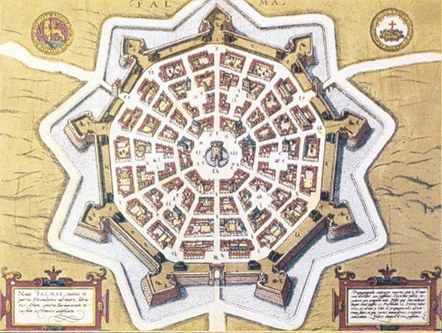
When I arrived there, we–I worked with Tom Bish and Koichiro Tanaka–we came up with the idea to make the Writing Machine [from Gulliver’s Travels, in which all the words in the language of Lagado were pasted onto the sides of cubes, which were set into a giant grid mechanism. As some students turned the 40 handles, the cubes rotated at random, and others transcribed the resulting nonsensical combinations of words into books, which, they believed, would eventually contain all the wisdom of culture, arts and sciences. Swift’s included a diagram of the automatic writing machine, but of course, it was just a picture of a grid surrounded by cranks. Not exactly a blueprint or anything. -ed.] But he wanted to put the model in the machine somehow.
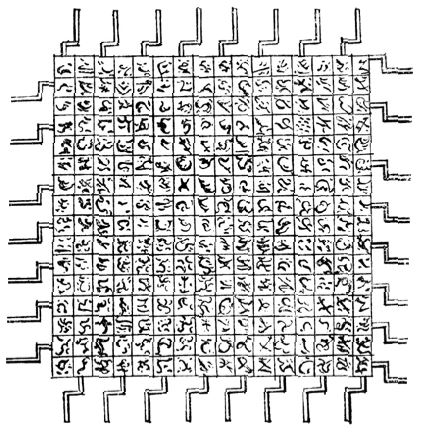
So I said I’ll cut the model into pieces and put them into the machine. And the students who built it were so pissed off. They’d spent weeks and weeks on it, and here I am, coming at them with an X-Acto saw.
G.O: No doubt. How did you–
H.L: Well, there was a whole strategy. And to do it, I projected–do you know the painting, Broadway Boogie Woogie?–I projected Broadway Boogie Woogie onto Palmanova and cut it into the strips of the painting. if you turned it with all the faces up, it’d turn into Broadway Boogie Woogie.
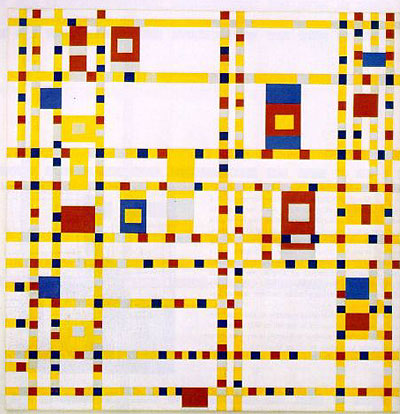
[via]
And on another face we put diagrams of constellations. Another face had names of saints. And I took Raymond Roussel’s book Impressions of Africa, and took all the names out of it, and found saints to correspond to each name. And we didn’t know what to do on the fourth side, and so he said put a mirror.
[ed. note: now that you mention it, all these references–Palmanova, the “star city” that “congeals into a ‘boogie woogie’ constellation,” a “Swiftian manner,” etc.–show up in Libeskind’s refrigerator-poetic text for the exhibit.]
Koichiro was the engineer for the turning mechanism. We wanted it so they’d turn and click into place, so they’d turn and lock into horizontal position. in addition, we wanted it so that when you turn the handle, it’d be unpredictable. you could turn the handle a whole revolution, and nothing, then suddenly one cube would turn, and another would turn the opposite direction. So it looked very random.
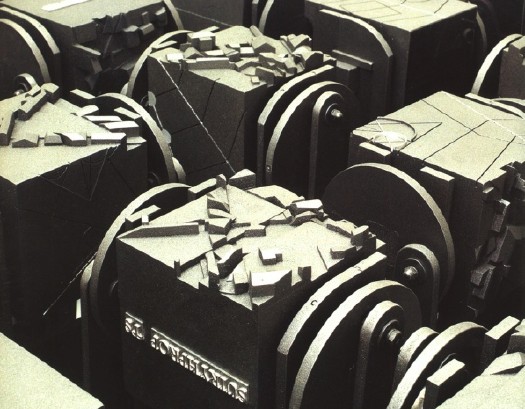
At Cranbrook we had all these great people, so we called up the person who was the head of Saturn at GM–which was top secret at the time–and he came out to the studio, to give us instructions. And he basically said he couldn’t make it work. But Koichiro actually figured it out. It was kind of like a locomotive, with a weird linkage, and there was a round disk with a swath cut out, that might be a 1/4, 2/4, 3/4 turn. It was a secret code, and we had a hell of a time with it. And at the same time we had tremendous time pressure.
We had a concern about how it would turn. And how to finish it. At first we tried staining it with ink, but he rejected that immediately. Detroit happens to have a factory where they make graphite, and they have every graphite available in the world, man-made and natural, so we went to the graphite plant and mixed it with laquer and sprayed it on with an industrial sprayer. Once we sprayed it, the surface was kind of suede-y, so we had to burnish all of it. And that took a long time.
Rossi actually came to Cranbrook, to visit the studio and to see what we were doing. [And to make sure it was happening. -ed.] He said he wanted to get two students to come to the Biennale to install Libeskind’s pieces–and to install the whole Biennale. I think Rossi had his students working on it, too–so I went with another student to do that, and it was an amazing experience.
G.O: Why was there so much pressure? Because you were behind schedule or something?
H.L: Because Libeskind was ready to leave Cranbrook, and he was picking a fight. He was already getting famous, and he’d just leave to teach somewhere–that was when he’d gone off to Harvard–and so they fired him, and gave him a deadline to vacate the campus. And they wouldn’t give us any money for materials–actually, they reneged on their promise to give money for materials. So we funded it. We found an old Pepsi machine and filled it with beer. And that’s how we funded it.
G.O: How about the other machines? Did they have dedicated teams, too?
H.L. Yeah, there were two guys who built the Reading Machine by themselves with no power tools, out of ash, which is an incredibly hard wood. I don’t know how they did it. They basically slept in the woodshop.
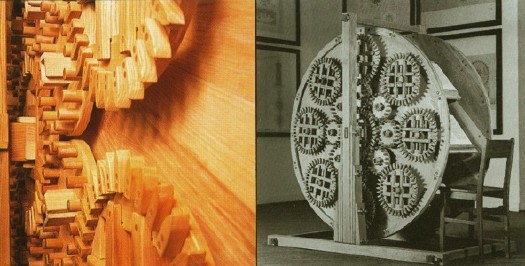
But when we got to Venice, the hot, humid air had swollen all the wood, so it wouldn’t turn. And the teeth on the gears would start snapping. So we had to sand all the parts down–for days–to get it to turn.
The Memory Theater Machine, there was a whole crew of people fighting through that with each other. There was no plan for that, they just put it all together. But the amazing thing was, all those pieces actually moved, they all worked.
For him it was never strictly an idea. The object itself was very important, and though he never built any of it himself, he was in the studio every day, especially with the Memory Machine. Because that was the one that didn’t have a plan of action.
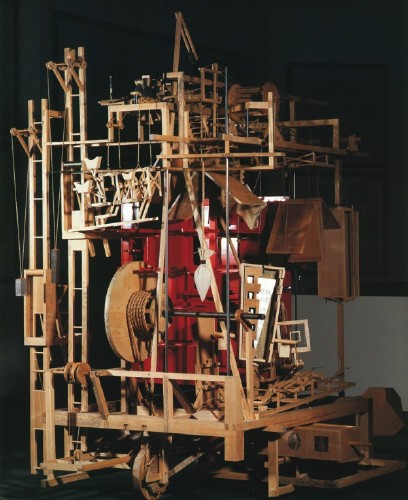
The whole thing was quite an amazing. Sometimes there’s like a historic moment, you know? The students who were there were basically enslaved, they were there to get an education, but Libeskind wouldn’t lecture. He’d just tell them to build these things.
G.O: What do you mean, he wouldn’t lecture?
H.L: I mean, the guy is an absolute mental genius, and I don’t say that lightly. He used to come into the studio and just start talking. And he would talk for an entire day. One thing led to another in the most eloquent and philosophical way. Students wouldn’t even talk. Everything was by implication, by story, and you had to figure out what the hell he meant.
One time he had gone to Harvard, and everyone was supposed to prepare work for him to review, right? Then when he came back, he came into the studio he spoke for three days straight. I mean, he’d talk all day, then go home at night, and come back and pick up right where he’d left off. And he never referred the work on the wall at all.
So people knew what the story was, and everything was interspersed with references to–you can’t believe what he’s read, he would quote from memory, and give you page numbers. He’d stop and say, “Go get such and such a book, and it’s on this page at the top.” It was that kind of a thing.
All these discussions were going on all the time, and the unwritten rule was you don’t talk about buildings. It was all about drawing and making, the crits he gave about work being done were always about the actual making of the thing: the drawing, the craft of building the models. He’d say, “Don’t say this is not architecture; this is architecture.” We were all trying to figure out what he meant.
But this was part of a historic discussion on philosophical terms, and not just on architecture, but on everything, really. And sometimes he’d bring people in–at that time he was very threatening to the establishment. So the guy who was running Harvard, Henry Cobb? He showed up at the studio to see what we were up to, and he picks a fight to say that this wasn’t architecture.
G.O: So they [the students] never learned any actual practical skills?
H.L: They didn’t teach it, but somehow it sunk in, which is a very interesting way of teaching. You could never come away and say you knew how architecture should be, or how anything should be. It was more like an approach and an attitude. For him, he often talked about honesty, about being real about what you’re doing, about really making something.
G.O: What happened afterward? Why were they going to Geneva, and what was the aftermath of them being destroyed like?
H.L: After the opening, I left Venice and came back, and I never heard anything of what happened to the actual pieces. But they lost track of them. Maybe it’s different today, but the people running the Biennale were completely discombobulated.
Then he got invited to show them at the Palais Wilson, and he called another student and I, and he said we have to find where these things are. So this guy Donald Bates was sent to Venice to track them down, and he, after two weeks, he finally found them in this warehouse. And they got shipped to the Palais Wilson. And then Libeskind asked me to fly to Geneva to install them. And the day before I left, I get this call from him, that a terrorist had thrown a firebomb and everything had burned up. and not to go.
A wild story, and we half didn’t know if it was true, you know, with him. But it was in the news, and it actually happened. The whole thing was so strange: that these things actually got built, and shown, and lost, and destroyed in the way they did.
G.O: So what happened?
Well, then there was a fight over the insurance. Libeskind was fighting with whoever was responsible for the insurance. And finally, the settlement was to fund another project, Line of Fire, and it had a catalogue that had the best documentation of the pieces.
G.O: So it was on to the next thing? No discussion of rebuilding them?
H.L: I thought of it a bit, but it was so much work. you know.
Previously: Do Daniel Libeskind’s awesome machines mean I have to stop hating his work?
Daniel Libeskind and the Grand Academy of Lagado
